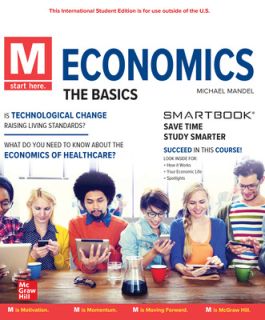M ISE
1260597423
·
9781260597424
Mandel's M: Economics, The Basics fourth edition focuses on developing a student's economic literacy without overwhelming to provide a window into what's happening in the current economy. Michael Mandel is the former Chief Economist for BusinessWeek …
Read More
After purchasing your eBook, login to the McGraw Hill Bookshelf website and redeem the access code from your order confirmation email.
- Access your eBook online or offline
- Easily highlight and take notes
- Fully searchable content
- Syncs across platforms
NOTE: eBook purchase does not include Connect homework or adaptive SmartBook assignments
CH 01: INTRODUCTION
CH 02: PRICES, BUYERS, AND SELLERS
CH 03: MATCHING SUPPLY AND DEMAND
CH 04: THE NATURE OF BUSINESS
CH 05: PERFECT COMPETITION
CH 06: HISTORICAL BACKGROUND
CH 07: MEASURING THE ECONOMY
CH 08: THE BASICS OF INFLATION
CH 09: THE SIGNIFICANCE OF GROWTH
CH 10: POTENTIAL VERSUS REAL GDP
CH 11: THE GOVERNMENT AND THE ECONOMY
CH 12: THE USES OF MONEY
CH 13: THE MARKET FOR LOANS
CH 14: THE NATURE OF INTERNATIONAL TRADE
CH 15: THE NATURE OF TECHNOLOGICAL CHANGE
CH 16: THE BASICS OF THE LABOR MARKET
CH 17: THE BASICS OF INCOME DISTRIBUTION
CH 18: THE BASICS OF RETIREMENT
CH 19: THE BASICS OF ENERGY CONSUMPTION AND SUPPLY
CH 02: PRICES, BUYERS, AND SELLERS
CH 03: MATCHING SUPPLY AND DEMAND
CH 04: THE NATURE OF BUSINESS
CH 05: PERFECT COMPETITION
CH 06: HISTORICAL BACKGROUND
CH 07: MEASURING THE ECONOMY
CH 08: THE BASICS OF INFLATION
CH 09: THE SIGNIFICANCE OF GROWTH
CH 10: POTENTIAL VERSUS REAL GDP
CH 11: THE GOVERNMENT AND THE ECONOMY
CH 12: THE USES OF MONEY
CH 13: THE MARKET FOR LOANS
CH 14: THE NATURE OF INTERNATIONAL TRADE
CH 15: THE NATURE OF TECHNOLOGICAL CHANGE
CH 16: THE BASICS OF THE LABOR MARKET
CH 17: THE BASICS OF INCOME DISTRIBUTION
CH 18: THE BASICS OF RETIREMENT
CH 19: THE BASICS OF ENERGY CONSUMPTION AND SUPPLY
Mandel's M: Economics, The Basics fourth edition focuses on developing a student's economic literacy without overwhelming to provide a window into what's happening in the current economy. Michael Mandel is the former Chief Economist for BusinessWeek magazine, now Senior Fellow at the Mack Institute for Innovation Management at The Wharton School of the University of Pennsylvania, as well as Chief Economic Strategist at the Progressive Policy Institute in Washington, DC. Mandel writes in a journalistic style drawing upon news articles and experience throughout the text to present economic concepts in a way that is understandable, relevant, and exciting for a broad audience. The succinct coverage, magazine-like design, and accessible presentation of math and graphs will help instructors overcome the common challenges of this course, and make the material more approachable and attractive to a wide range of students.

